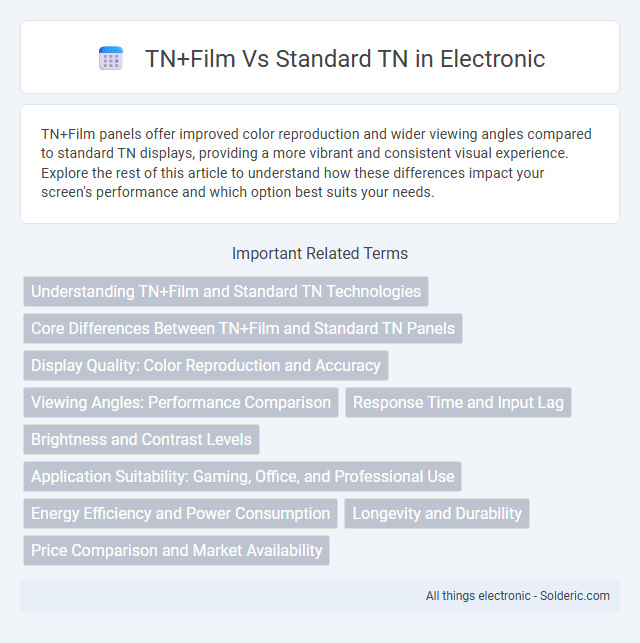TN+Film panels offer improved color reproduction and wider viewing angles compared to standard TN displays, providing a more vibrant and consistent visual experience. Explore the rest of this article to understand how these differences impact your screen's performance and which option best suits your needs.
Comparison Table
| Feature | TN+Film | Standard TN |
|---|---|---|
| Panel Technology | Twisted Nematic with Film enhancement | Basic Twisted Nematic |
| Color Accuracy | Improved color reproduction | Lower color accuracy |
| Viewing Angles | Wider viewing angles | Narrow viewing angles |
| Response Time | Fast response (1-5 ms) | Fast response (1-5 ms) |
| Contrast Ratio | Higher contrast ratio | Standard contrast ratio |
| Cost | Moderately higher price | Lower cost |
| Use Case | Gaming, professional use | Basic computing tasks |
Understanding TN+Film and Standard TN Technologies
TN+Film technology enhances traditional Standard TN panels by adding a polymer film layer, which improves image uniformity and viewing angles without significantly increasing manufacturing costs. Standard TN panels utilize twisted nematic liquid crystals that offer fast response times but suffer from narrow viewing angles and limited color reproduction. The incorporation of the film layer in TN+Film reduces light leakage and improves contrast, resulting in better overall image quality compared to conventional TN displays.
Core Differences Between TN+Film and Standard TN Panels
TN+Film panels enhance standard TN technology by incorporating a film layer that improves color accuracy and viewing angles, addressing major limitations of traditional TN displays. Standard TN panels typically offer faster response times and lower input lag, appealing to competitive gamers, but suffer from narrow viewing angles and less vibrant colors. Your choice depends on whether you prioritize color performance and wider viewing experience (TN+Film) or ultra-fast responsiveness (standard TN).
Display Quality: Color Reproduction and Accuracy
TN+Film panels enhance color reproduction and accuracy compared to standard TN displays by incorporating a thin film layer that improves light diffusion and viewing angles. This results in richer and more consistent color output, reducing the color shifting typically seen in traditional TN monitors. Consequently, TN+Film technology delivers more vibrant visuals, making it ideal for applications requiring better color fidelity without the higher cost of IPS or VA panels.
Viewing Angles: Performance Comparison
TN+Film panels offer improved viewing angles compared to standard TN displays, reducing color shifting and contrast loss when viewed from the sides. This enhancement is achieved through additional film layers that control light diffusion more effectively. As a result, TN+Film technology provides a more consistent visual experience across wider angles, making it preferable for multi-user environments and varied viewing positions.
Response Time and Input Lag
TN+Film panels typically offer faster response times than standard TN displays, often achieving 1ms gray-to-gray transitions, which significantly reduces motion blur in fast-paced gaming. Input lag in TN+Film monitors is also minimized due to advanced circuit optimizations, making these panels preferable for competitive gamers seeking quick reaction times. Standard TN screens usually have slightly higher response times and input lag, which can impact overall gaming performance and visual clarity during rapid movements.
Brightness and Contrast Levels
TN+Film panels offer higher brightness levels, typically reaching up to 300-350 nits, compared to standard TN panels that usually max out around 200-250 nits, enhancing visibility in well-lit environments. Contrast ratios on TN+Film displays are improved, often achieving values near 1000:1, which provides deeper blacks and more distinct image separation over the lower contrast ratios of standard TN panels that hover around 600:1. These enhancements make TN+Film technology more suitable for applications requiring sharper visuals and better color depth without significantly increasing response time or manufacturing costs.
Application Suitability: Gaming, Office, and Professional Use
TN+Film displays faster response times and higher refresh rates compared to Standard TN, making it more suitable for competitive gaming where motion clarity is critical. Standard TN panels offer adequate performance for office tasks with lower power consumption and cost, but lack the improved color accuracy and viewing angles required for professional use. TN+Film's enhanced image quality favors graphic design and video editing applications while still maintaining TN's low input lag benefits.
Energy Efficiency and Power Consumption
TN+Film panels offer improved energy efficiency compared to standard TN displays due to their enhanced liquid crystal alignment, which reduces the voltage required for pixel activation. This results in lower power consumption, making TN+Film technology a more environmentally friendly and cost-effective choice for your devices. Higher energy efficiency of TN+Film panels contributes to longer battery life in portable electronics, supporting sustainable usage without sacrificing performance.
Longevity and Durability
TN+Film panels offer enhanced longevity and durability compared to standard TN displays due to their advanced layered film technology, which provides better resistance to wear and environmental stress. The film layer in TN+Film reduces susceptibility to color degradation and mechanical damage, extending the panel's operational lifespan. This makes TN+Film an ideal choice for devices requiring prolonged use and reliable performance under demanding conditions.
Price Comparison and Market Availability
TN+Film panels typically cost more than standard TN displays due to improved viewing angles and color accuracy, making them a mid-range option for budget-conscious buyers. Standard TN panels dominate the market with widespread availability, especially in entry-level monitors and laptops, providing lower pricing but at the expense of image quality. When choosing your display, consider if the higher price of TN+Film aligns with your needs for better visual performance and if it's easily accessible from your preferred retailers.
TN+Film vs Standard TN Infographic

 solderic.com
solderic.com